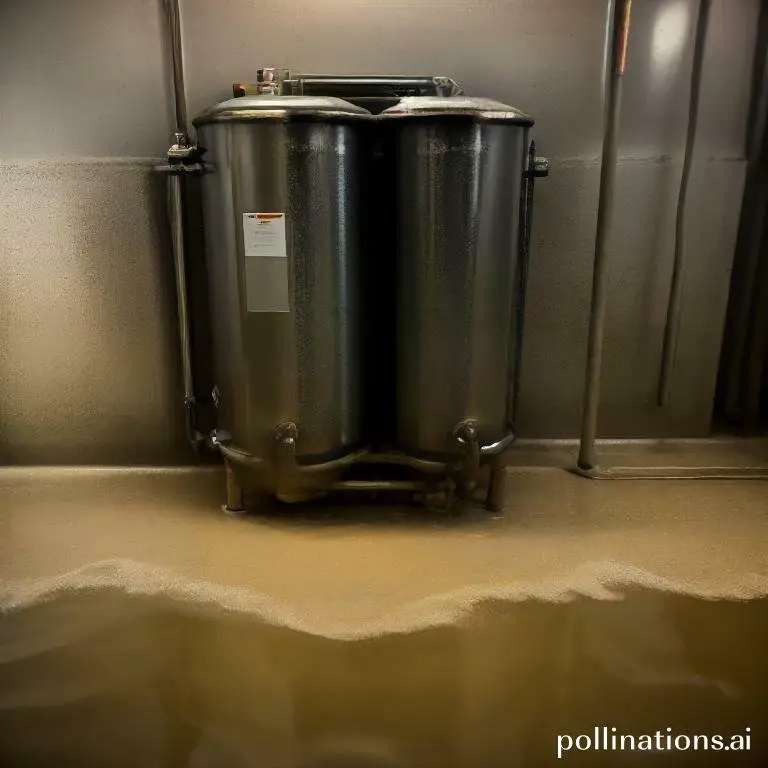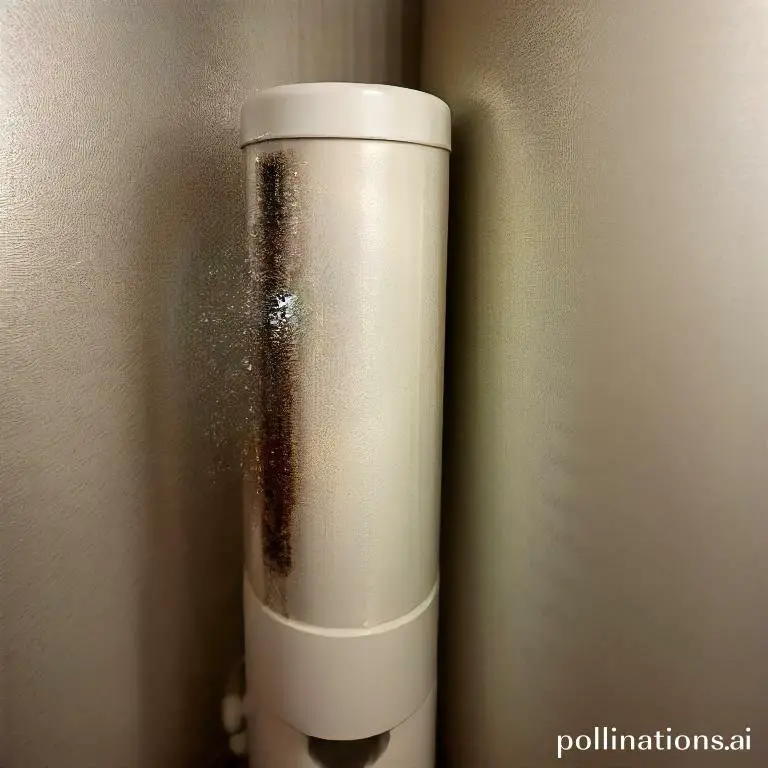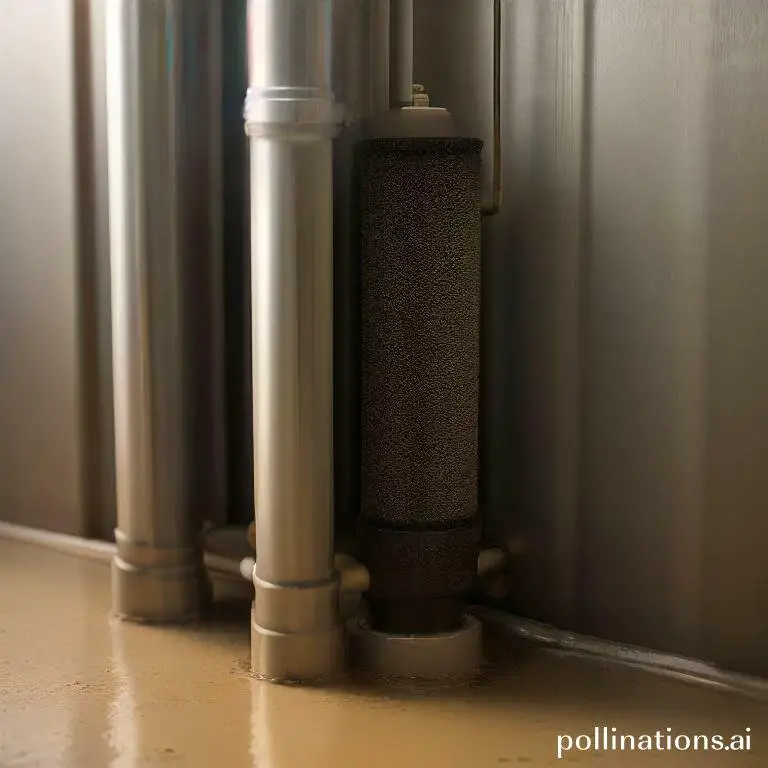
II. Sediment can cause overheating and corrosion, shortening the lifespan of the water heater.
III. Regular maintenance and flushing of the water heater can prevent sediment buildup and extend the life of the unit.
Yes, sediment can indeed damage water heater components. Over time, minerals and debris can accumulate at the bottom of the tank, forming sediment.
This sediment can create a barrier between the heating element and the water, reducing the efficiency of the heater and potentially causing it to overheat. Additionally, sediment can corrode the tank and other components, leading to leaks and costly repairs.
Regular maintenance, such as flushing the tank to remove sediment, is essential to ensure the longevity and efficient operation of your water heater.
What is sediment?
In the context of water heaters, sediment refers to the accumulation of solid particles that settle at the bottom of the tank over time. These particles can include minerals, rust, sand, and other debris that enter the water supply.
Definition of sediment in the context of water heaters
Sediment in water heaters refers to the buildup of solid materials that settle at the bottom of the tank. These sediments can affect the efficiency and performance of the water heater, leading to various issues if not addressed.
How sediment forms in water heaters
Sediment forms in water heaters due to the presence of minerals and impurities in the water supply. When the water is heated, these substances separate from the water and settle at the bottom of the tank. Over time, the sediment layer thickens and can cause problems.
Sediment can affect the performance of a water heater in several ways. To start with, it acts as an insulating barrier between the heating element and the water, reducing the efficiency of heat transfer. This can result in longer heating times and increased energy consumption.
Additionally, sediment buildup can lead to the corrosion of the tank and other components. The sediments can trap moisture, creating a favorable environment for rust and other forms of corrosion. This can weaken the tank and eventually lead to leaks or even tank failure.
To prevent these issues, regular maintenance and sediment removal are crucial. Flushing the water heater periodically can help remove the accumulated sediments and improve its performance. This can be done by connecting a hose to the drain valve and allowing the sediment-laden water to drain out.
| Sediment Types | Effects |
|---|---|
| Minerals | Reduce heating efficiency |
| Rust | Corrosion of tank and components |
| Sand and debris | Blockage of pipes and valves |
How sediment damages water heater components
Sediment can have a detrimental impact on various components of a water heater. Embracing how sediment buildup affects the efficiency of the water heater is crucial for its proper functioning and longevity.
Elucidation of the impact of sediment on various components
One of the main components that can be affected by sediment buildup is the heating element. Sediment particles settle at the bottom of the tank and can accumulate on the heating element, forming a thick layer. This layer acts as an insulator, making it harder for the heating element to transfer heat to the water. As a result, the water takes longer to heat up, leading to increased energy consumption and higher utility bills.
In addition to the heating element, sediment can also damage the tank itself. The accumulation of sediment can cause corrosion and rusting, weakening the structural integrity of the tank. This can eventually lead to leaks and water damage.
Furthermore, sediment can clog the water lines and valves connected to the water heater. This restricts the flow of water, causing reduced water pressure and potential damage to the valves. It can also result in uneven distribution of hot water throughout the house, leading to inconvenience for the users.
How sediment buildup affects the efficiency of the water heater
The buildup of sediment in a water heater significantly reduces its efficiency. As sediment accumulates, it acts as an insulating barrier, making it harder for the heating element to transfer heat to the water. This leads to longer heating times and increased energy consumption.
Moreover, the presence of sediment can cause the water heater to overheat. The insulating effect of sediment prevents proper heat dissipation, causing the temperature inside the tank to rise excessively. This can not only damage the heating element but also increase the risk of scalding for users.
Additionally, the accumulation of sediment can lead to frequent system malfunctions and breakdowns. The clogging of water lines and valves can cause pressure imbalances and hinder the proper functioning of the water heater. This can result in reduced hot water supply and compromised user experience.
To ensure the longevity and efficiency of a water heater, imperative to regularly flush out sediment and perform maintenance. This involves draining the tank to remove accumulated sediment, cleaning the heating element, and inspecting the tank for any signs of corrosion or damage.
Signs of sediment buildup in water heaters
Sediment buildup in water heaters can cause various problems and affect the performance of the appliance. Fundamental to be aware of the signs that indicate sediment accumulation, so that prompt action can be taken to prevent any damage or malfunction. Here are some common symptoms to look out for:
1. Reduced hot water flow
One of the first signs of sediment buildup in a water heater is a decrease in the flow of hot water. As sediment settles at the bottom of the tank, it takes up space and reduces the volume available for hot water storage. This can result in lower water pressure and a slower flow rate, making it harder to get sufficient hot water for your needs.
2. Strange noises
If you hear unusual noises coming from your water heater, such as popping, cracking, or rumbling sounds, it could be an indication of sediment buildup. As the sediment gets heated, it can create pockets of trapped air that burst and produce these noises. Ignoring these sounds may lead to further damage to the water heater.
3. Increased energy consumption
Sediment accumulation in a water heater can decrease its efficiency and cause it to consume more energy. The layer of sediment acts as an insulator, making it harder for the heat to transfer from the heating element to the water. This forces the heater to work harder and use more energy to maintain the desired water temperature, resulting in higher energy bills.
4. Inconsistent water temperature
Another sign of sediment buildup is inconsistent water temperature. As the sediment settles at the bottom of the tank, it can form a barrier between the heating element and the water. This can lead to uneven heat distribution and cause fluctuations in the water temperature, making it difficult to get a steady supply of hot water.
How to identify sediment buildup
Now that you are aware of the signs of sediment buildup, imperative to know how to identify it in your water heater. Here are some steps you can take:
1. Visual inspection
Inspect the bottom of your water heater tank for any visible signs of sediment. Sediment often appears as a layer of debris or sediment particles settled at the bottom.
2. Draining the tank
You can also drain a small amount of water from the tank into a bucket or container. If you notice sediment particles or discolored water, it is a clear indication of sediment buildup.
3. Professional inspection
If you are unsure about the presence of sediment or if you suspect a significant buildup, it is recommended to consult a professional plumber or water heater technician. They can inspect the tank thoroughly and provide expert advice on the best course of action.
Can sediment damage water heater components?
Yes, sediment buildup can damage various components of a water heater if left untreated. The accumulation of sediment can cause the following issues:
1. Reduced efficiency
Sediment acts as an insulating layer, reducing the efficiency of the water heater. This can lead to increased energy consumption and higher utility bills.
2. Corrosion
Sediment can trap moisture against the tank’s surface, creating a conducive environment for corrosion. Over time, this can weaken the tank and lead to leaks or even a complete failure.
3. Clogged pipes and valves
If sediment travels through the water heater, it can accumulate in pipes and valves, causing blockages. This can restrict water flow, decrease water pressure, and potentially damage other plumbing fixtures.
Therefore, it is crucial to regularly inspect and flush out any sediment buildup in your water heater to maintain its efficiency, extend its lifespan, and prevent costly repairs.

Preventing Sediment Buildup in Water Heaters
Best practices for preventing sediment buildup
Sediment buildup in water heaters can lead to reduced efficiency and even damage to the heating system. By upholding these best practices, you can prevent sediment buildup and ensure the longevity of your water heater:
- Flush the tank regularly: Flushing the tank helps remove sediment that has settled at the bottom. This should be done at least once a year to maintain optimal performance.
- Install a sediment filter: A sediment filter can be installed on the water supply line to trap sediment before it enters the water heater, reducing the amount that accumulates in the tank.
- Check the anode rod: The anode rod is designed to attract corrosive elements in the water, protecting the tank from rust and sediment buildup. Regularly inspect and replace the anode rod if necessary.
- Adjust the temperature: Higher temperatures can accelerate sediment buildup. Set the water heater temperature to a moderate level to minimize sediment formation.
Regular maintenance tips
In addition to following the best practices mentioned above, regular maintenance can further prevent sediment buildup in water heaters. Here are some additional tips:
- Inspect the pressure relief valve: The pressure relief valve helps release excess pressure and prevent tank damage. Regularly check the valve for proper functioning and replace if needed.
- Monitor water quality: Hard water with high mineral content can contribute to sediment buildup. Consider installing a water softener system to reduce mineral deposits.
- Keep the area around the water heater clean: Dust and debris can accumulate around the water heater and potentially enter the tank. Keep the area clean to minimize the introduction of foreign particles.
| Preventive Measures | Frequency |
|---|---|
| Flush the tank | At least once a year |
| Install a sediment filter | As needed |
| Check the anode rod | Regularly inspect and replace if necessary |
| Adjust the temperature | Set to a moderate level |
| Inspect the pressure relief valve | Regularly check and replace if needed |
| Monitor water quality | Consider installing a water softener system |
| Keep the area clean | Regularly clean around the water heater |

Removing Sediment from Water Heaters
As for maintaining the efficiency and longevity of your water heater, removing sediment is a crucial step. Sediment buildup can cause a range of issues, including reduced heating performance and increased energy consumption. In this comprehensive guide, we will walk you through the step-by-step process of removing sediment from your water heater.
Step 1: Turn Off the Power
Before you begin, ensure that the power supply to the water heater is turned off. This is essential for your safety during the sediment removal process.
Step 2: Gather the Required Tools
To successfully remove sediment from your water heater, you will need the following tools:
- A garden hose
- An adjustable wrench
- A bucket or a drain pan
Step 3: Connect the Garden Hose
Attach one end of the garden hose to the drain valve of the water heater. Make sure it is securely connected to prevent any leaks.
Step 4: Drain the Sediment
Place the other end of the garden hose in a suitable drainage area, such as a floor drain or a bucket. Open the drain valve on the water heater to allow the sediment to flow out through the hose. Be patient, as this process may take some time.
Step 5: Flush the Water Heater
Once the sediment has been drained, close the drain valve and remove the garden hose. Turn on a hot water faucet in your home to allow air to enter the system and facilitate the flushing process. Let the water run until it flows smoothly without any signs of sediment.
Step 6: Refill the Water Heater
Once the water runs clear, turn off the faucet and close it. Proceed to refill the water heater by opening the cold water supply valve. Ensure that the water level reaches the appropriate level indicated on the water heater.
Step 7: Restore Power
Finally, turn the power supply back on and wait for the water heater to heat up. Once it reaches the desired temperature, you can now enjoy the benefits of a sediment-free water heater.
Bottom Line
Yes, sediment can damage water heater components and reduce its efficiency. Sediment buildup can cause the heating element to overheat, leading to premature failure and costly repairs. It can also reduce the amount of hot water available and increase energy consumption. Regular maintenance, such as flushing the tank and replacing the anode rod, can help prevent sediment buildup and extend the life of your water heater. If you notice any signs of sediment buildup, such as discolored water or strange noises, it’s important to address the issue promptly to avoid further damage. By taking care of your water heater, you can ensure reliable hot water and save money on energy bills in the long run.
Read More:
1. Impact Of Sediment On Water Heater Lifespan
2. Using A Shop Vac For Sediment Removal In Water Heaters










